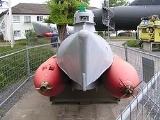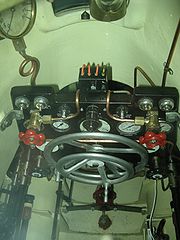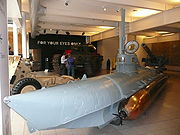
Biber
Encyclopedia
The Biber (German for "beaver
Beaver
The beaver is a primarily nocturnal, large, semi-aquatic rodent. Castor includes two extant species, North American Beaver and Eurasian Beaver . Beavers are known for building dams, canals, and lodges . They are the second-largest rodent in the world...
") was a German midget submarine
Midget submarine
A midget submarine is any submarine under 150 tons, typically operated by a crew of one or two but sometimes up to 6 or 8, with little or no on-board living accommodation...
of the Second World War. Armed with two externally mounted 21-inch (53 cm) torpedo
Torpedo
The modern torpedo is a self-propelled missile weapon with an explosive warhead, launched above or below the water surface, propelled underwater towards a target, and designed to detonate either on contact with it or in proximity to it.The term torpedo was originally employed for...
es or mines, they were intended to attack coastal shipping. They were the smallest submarines in the Kriegsmarine
Kriegsmarine
The Kriegsmarine was the name of the German Navy during the Nazi regime . It superseded the Kaiserliche Marine of World War I and the post-war Reichsmarine. The Kriegsmarine was one of three official branches of the Wehrmacht, the unified armed forces of Nazi Germany.The Kriegsmarine grew rapidly...
.
The Biber was hastily developed to help meet the threat of an Allied invasion of Europe
D-Day
D-Day is a term often used in military parlance to denote the day on which a combat attack or operation is to be initiated. "D-Day" often represents a variable, designating the day upon which some significant event will occur or has occurred; see Military designation of days and hours for similar...
. This resulted in basic technical flaws that, combined with the inadequate training of their operators, meant they never posed a real threat to Allied shipping, despite 324 submarines being delivered. One of the class's few successes was the sinking of the cargo ship Alan A. Dale
Alan A. Dale
The Alan A. Dale was originally a Danish cargo ship named Norvest, long, wide and 4,700 tons. After the outbreak of World War II she remained in port in the United States. She was one of 84 foreign ships seized by the United States under the Ship Requisition Act, signed on June 6, 1941...
.
A number have survived in museums including one example that has been restored to operational condition.
Development
Construction of the first prototype began in February 1944 and was completed in less than 6 weeks. The initial prototype was officially titled Bunteboot (but better known as Adam) was heavily influenced by the British Welman submarineWelman submarine
The Welman submarine was a Second World War one-man British midget submarine developed by the Special Operations Executive. It only saw action once and was never particularly successful.-Design:...
. It differed from the final design in a number of respects such as being nearly 2 meters shorter. Following testing on the Trave
Trave
The Trave is a river in Schleswig-Holstein, Germany. It is approximately 124 kilometres long, running from its source near the village of Gießelrade in Ostholstein to Travemünde where it flows into the Baltic Sea. It passes through Bad Segeberg, Bad Oldesloe, and Lübeck, where it is linked to the...
river on 29 May twenty four Bibers were ordered.
Design

The submarine could be armed with either two TIIIc torpedoes with neutral buoyancy (achieved by limiting the number of batteries on board), mines or a mixture of the two.
The Biber was powered on the surface by a 32 hp Otto blitz petrol engine which was used despite concerns about the risks posed by the carbon monoxide
Carbon monoxide
Carbon monoxide , also called carbonous oxide, is a colorless, odorless, and tasteless gas that is slightly lighter than air. It is highly toxic to humans and animals in higher quantities, although it is also produced in normal animal metabolism in low quantities, and is thought to have some normal...
the engine gave off. The engine had the advantage of being cheap and available in large numbers. Propulsion while submerged was provided by a 13 horse power electric motor powered by three Type T13 T210 battery troughs.
Operation
Biber operations were carried out under the auspices of the K-VerbandK-Verband
The K-Verband was a World War II German naval unit that operated a mixture of Midget submarines and explosive speed boats....
, a German naval unit which operated a mixture of midget submarines and explosive speedboats. The training of Biber operators was originally planned to take eight weeks, but the initial group of pilots was rushed through in just three weeks. Planning also called for flotillas of 30 boats and pilots with just under 200 shore support crew.
Operations generally lasted from one to two days with pilots either using a drug known as DIX to stay awake on longer missions or caffeine
Caffeine
Caffeine is a bitter, white crystalline xanthine alkaloid that acts as a stimulant drug. Caffeine is found in varying quantities in the seeds, leaves, and fruit of some plants, where it acts as a natural pesticide that paralyzes and kills certain insects feeding on the plants...
-laced chocolate. The poor quality of the Biber's periscope meant that night attacks had to be carried out on the surface.
Fécamp harbour

Fécamp
Fécamp is a commune in the Seine-Maritime department in the Haute-Normandie region in northern France.-Geography:Fécamp is situated in the valley of the river Valmont, at the heart of the Pays de Caux, on the Albaster Coast...
harbour. Twenty-two boats were launched but only 14 were able to leave the harbour and of those fourteen only two managed to reach their operational area. The bibers were then withdrawn to Mönchengladbach
Mönchengladbach
Mönchengladbach , formerly known as Münchengladbach, is a city in North Rhine-Westphalia, Germany. It is located west of the Rhine half way between Düsseldorf and the Dutch border....
.
Operations in the Scheldt Estuary
In December 1944 it was decided to deploy Bibers against traffic to Antwerp in the Scheldt Estuary. The force was based at RotterdamRotterdam
Rotterdam is the second-largest city in the Netherlands and one of the largest ports in the world. Starting as a dam on the Rotte river, Rotterdam has grown into a major international commercial centre...
with forward bases at Poortershavn and Hellevoetsluis
Hellevoetsluis
Hellevoetsluis is a small city and municipality on Voorne-Putten Island in the western Netherlands, in the province of South Holland...
. The first attack took place on the night of the 22/23 of December. Eighteen Biber were involved of which only one returned. The only allied loss caused by the operation was Alan A. Dale. Further operations between the 23rd and the 25th achieved no success and none of the 14 submarines deployed survived. On the 27th the accidental release of a torpedo in the Voorneschen resulted in the sinking of 11 Bibers (although they were latter recovered). The 3 undamaged bibers later sailed again; none returned. An operation on the night 29/30 January resulted in damage to (much of it due to ice) or loss of most of the remaining Bibers. Losses combined with RAF bombing prevented attacks from being mounted in February 1945. The bombing had damaged the cranes used to move the Bibers into and out of the water. Reinforcements allowed operations to continue until April 1945 but no successes were achieved and the Biber flotillas continued to take a very high rate of losses. The last Biber mission was an attempt at mine laying and took place on the night of 26 April. Of the 4 Bibers that took part one ran aground and three were attacked by Thunderbolts
P-47 Thunderbolt
Republic Aviation's P-47 Thunderbolt, also known as the "Jug", was the largest, heaviest, and most expensive fighter aircraft in history to be powered by a single reciprocating engine. It was heavily armed with eight .50-caliber machine guns, four per wing. When fully loaded, the P-47 weighed up to...
which sank two of them.
Attempted attack on Vaenga Bay

Severomorsk
Severomorsk is a closed town in Murmansk Oblast, Russia, located about north of Murmansk along the Kola Bay. Population: This is the main administrative base of the Russian Northern Fleet. Severomorsk has the largest drydock on the Kola Peninsula....
in the Kola Inlet. The hope was either to attack one of the convoys that stopped there to refuel and take on ammunition or to attack the Soviet battleship Arkhangelsk (HMS Royal Sovereign
HMS Royal Sovereign (05)
HMS Royal Sovereign was a Revenge-class battleship of the Royal Navy displacing and armed with eight guns in four twin turrets...
on loan to the USSR). As it happened neither the battleship nor a convoy were in the port at the time of the planned attack. The plan was for U-boats to carry the Bibers within range of the harbour. U-295, U-318 and U-716 set off from Harstad
Harstad
is the second largest city and municipality by population, in Troms county, Norway – the city is also the third largest in North Norway. Thus Harstad is the natural centre for its district. Situated approximately north of the Arctic Circle, the city celebrated its 100th anniversary in...
on 5 January with Bibers mounted on their casings. Vibrations from the U-boats’ engines caused the Bibers stern glands to leak allowing water to reach the machinery space and as a result the mission was abandoned.
Further developments
Planning for two man versions (Biber II and Biber III) began but never got off the drawing board.Surviving examples

- Biber No.90
- This craft is displayed at the Imperial War MuseumImperial War MuseumImperial War Museum is a British national museum organisation with branches at five locations in England, three of which are in London. The museum was founded during the First World War in 1917 and intended as a record of the war effort and sacrifice of Britain and her Empire...
, London. It was one of three Bibers launched from the canal at HellevoetsluisHellevoetsluisHellevoetsluis is a small city and municipality on Voorne-Putten Island in the western Netherlands, in the province of South Holland...
in late December 1944. It was found sinking 49 miles (78.9 km) NE of DoverDoverDover is a town and major ferry port in the home county of Kent, in South East England. It faces France across the narrowest part of the English Channel, and lies south-east of Canterbury; east of Kent's administrative capital Maidstone; and north-east along the coastline from Dungeness and Hastings...
on 29 December 1944, its crewman had failed to properly close the engine exhaust system and died from resultant carbon monoxideCarbon monoxideCarbon monoxide , also called carbonous oxide, is a colorless, odorless, and tasteless gas that is slightly lighter than air. It is highly toxic to humans and animals in higher quantities, although it is also produced in normal animal metabolism in low quantities, and is thought to have some normal...
poisoning. HMS Ready took it in tow and, even when it sank close to Dover harbour entrance, the Royal NavyRoyal NavyThe Royal Navy is the naval warfare service branch of the British Armed Forces. Founded in the 16th century, it is the oldest service branch and is known as the Senior Service...
still raised it and subjected it to extensive trials. One oddity discovered during the initial search of the boat was:
- a bottle hidden under the seat and inside was a document in English, which, romantic as it read, appeared to have some bearing :on upon the capture of the submarine, and possibly the explanation of why the pilot met his end.
- That is all that the report says about that finding, any further details appear to have been lost.
- Biber No.105
- This Biber held by the Royal Navy Submarine MuseumRoyal Navy Submarine MuseumThe Royal Navy Submarine Museum at Gosport is a museum tracing the international history of submarine development from the age of Alexander the Great to the present day, and particularly the history of the Submarine Service from the tiny Holland 1 to the nuclear powered Vanguard class submarine...
, Gosport. It is in a working condition and believed to be the only fully operational World War 2 submarine in existence. The submarine was restored to working condition by apprentices from Fleet Support Limited in 2003 under the guidance of Ian Clark. The restoration featured in the third series of Channel 4's television programme, Salvage SquadSalvage SquadSalvage Squad is a television programme in which the "Salvage Squad" faced the challenge of restoring an item of classic machinery. The task was usually against a tight deadline, such as a public unveiling at a vehicle rally...
.
- Biber at the Nederlands Kustverdedigingsmuseum, Hook of Holland
- This example was discovered in 1990 during dredging operations in the Nieuwe WaterwegNieuwe WaterwegThe Nieuwe Waterweg is a ship canal in the Netherlands from het Scheur west of the town of Maassluis to the North Sea at Hook of Holland...
, in the Netherlands. It has since been restored.
Three more Bibers can be seen in the Netherlands; one in Vlissingen
Flushing, Netherlands
Vlissingen is a municipality and a city in the southwestern Netherlands on the former island of Walcheren. With its strategic location between the Scheldt river and the North Sea, Vlissingen has been an important harbour for centuries. It was granted city rights in 1315. In the 17th century...
, at Fort Rammekens, and another at the Overloon War Museum
Overloon War Museum
The National War and Resistance Museum of the Netherlands is located at Overloon, municipality Boxmeer....
. The third Biber is privately owned and displayed outdoors at Sloten near Amsterdam
Amsterdam
Amsterdam is the largest city and the capital of the Netherlands. The current position of Amsterdam as capital city of the Kingdom of the Netherlands is governed by the constitution of August 24, 1815 and its successors. Amsterdam has a population of 783,364 within city limits, an urban population...
, it has been painted red and white and serves as an advertising sign.
Other Bibers are displayed at the Deutsches Museum
Deutsches Museum
The Deutsches Museum in Munich, Germany, is the world's largest museum of technology and science, with approximately 1.5 million visitors per year and about 28,000 exhibited objects from 50 fields of science and technology. The museum was founded on June 28, 1903, at a meeting of the Association...
in Berlin
Berlin
Berlin is the capital city of Germany and is one of the 16 states of Germany. With a population of 3.45 million people, Berlin is Germany's largest city. It is the second most populous city proper and the seventh most populous urban area in the European Union...
, the Technikmuseum Speyer in Speyer
Speyer
Speyer is a city of Rhineland-Palatinate, Germany with approximately 50,000 inhabitants. Located beside the river Rhine, Speyer is 25 km south of Ludwigshafen and Mannheim. Founded by the Romans, it is one of Germany's oldest cities...
, Germany. Two examples survive in Norway, one at the Royal Norwegian Navy Museum
Royal Norwegian Navy Museum
The Royal Norwegian Navy Museum is a museum documenting the history of the Royal Norwegian Navy. It is located at the former main naval base of Karljohansvern in Horten. The museum was founded by C.F. Klinck on 24 August 1853...
and another at the Haakonsvern
Haakonsvern
Haakonsvern is the main base of the Royal Norwegian Navy and the largest naval base in the Nordic area. The base is located at Mathopen within Bergen municipality, about 15 km south-west of the city centre...
naval base.
External links
- Extended Biber informationsite.
- Salvage Squad - A Biber-class submarine (No.105) was fully restored by the UKChannel 4Channel 4Channel 4 is a British public-service television broadcaster which began working on 2 November 1982. Although largely commercially self-funded, it is ultimately publicly owned; originally a subsidiary of the Independent Broadcasting Authority , the station is now owned and operated by the Channel...
television program Salvage SquadSalvage SquadSalvage Squad is a television programme in which the "Salvage Squad" faced the challenge of restoring an item of classic machinery. The task was usually against a tight deadline, such as a public unveiling at a vehicle rally...
.

